DOF Portraits, Northern Road Trip

Feature Photograph
Night scenes of otherwise boring cityscapes are very popular. Unfortunately few of the ones I see have enough contrasting compositional elements to keep them interesting. Many photographers think because they’re photographing pretty lights, or a neat effect like car headlights streaming together, that this is all you need. It’s not. You need (as always) dimension, depth, a subject, perhaps a sub-subject, AND pretty lights and neat effects.

In the above image the obvious subject is the ongoing construction on what will one day be a bustling sky train station. The subject has halogen work lights casting their own color temperature on some massive concrete supports and work trucks and the such, and on a different level you can see the expressway lit by tungsten lights casting a second color temperature with car lights of the same temp streaming together in that blur effect so many enjoy capturing. Above that scene a small city of buildings with a major hotel individually lit by a third color temperature light.. altogether creating a multi-dimensional scene with several points of interest. I like this photograph and it’s significant because of the compositional elements, but I have a long way to go before I come close to mastering night landscapes.

This next night scene landscape was captured the same evening. It has five major compositional elements and four dimensions, perhaps more. The ¾ moon hangs low over the horizon, in the very left you have a vertical tower with red lights, right below it a small concentrated market area with its lights, and starting in the middle right almost all the way over to the middle left you have two rows of orange(ish) lights which are really the street lights on two major Bangkok Thanon’s. The yet to be completed sky train intersects the scene diagonally. It’s not great, perhaps it’s not even good. But it was thought out and planned and includes as many compositional elements as I thought would go together well.
I love night scene landscapes. Someday I’d like to do them very well. It’s not my photography skills I need to improve, if I saw the scene I know I have the skills to properly capture it. Where I need to develop is my “eye, that part in my brain which allows me to pick out something abstract as unique, that everyone else doesn’t see, and to do this 4-5 times in the same scene with contrasting and interesting elements. Some people naturally have this ability, some will never have this ability, and most of us, if we want it bad enough, will have to develop it over a long period. It’s not unusual for me to set and look at a scene for hours before taking out my camera. People ask what I’m doing. I tell them I’m “developing..”
Weekly Photo Outing
This week will be different. No major tourist attraction, no tigers, no Great Walls, but perhaps something even more rare to many living in Thailand for any length of time. I can’t believe the number of expats living in Thailand who believe the earth is flat.. or at least Thailand is flat. They tell me they miss the mountains, the evergreens, the rivers and the wildlife. Do you know that Thailand has approximately 300-600 wild tigers roaming the land? Friends, you’ve gotta get out of cement and smoky prison of Krung Threp and come take a drive with me up north. This outing is going to concentrate on a small but well traveled strip of highway 118 on a drive from Chiang Mai to Chiang Rai.
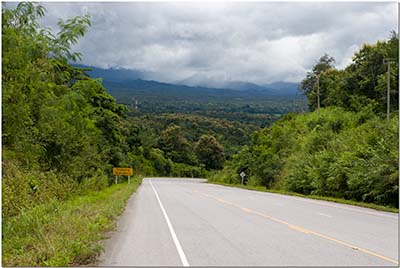
Less than 20km’s outside of Chiang Rai near Amphoe Doi Saket you start climbing a roughly 6% grade. Everything has turned green by now and tall trees and thick forests are everywhere. The elevation continues to rise into Bang Pan Daeng and by now you’re really enjoying the view.
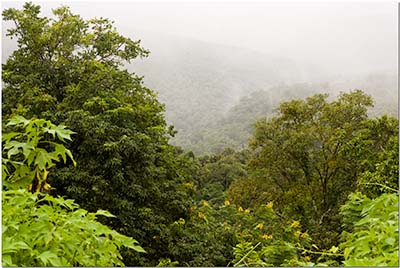
The summit passes by almost unnoticed as you start your descent into Amphoe Wiang Pa Pao. A word of caution. Most tires sold in Bangkok have a very hard rubber compound with a steep tread wear rating. This compound is great for crawling around Bangkok in heavy slow traffic year after year without needing a tire change, but it’s very limited in grip, especially in the wet stuff, which affects your ability to safely corner, brake, and maintain traction. Combine these economical tires with the relatively small brakes (compared to the same models sold in western countries) sold on Thailand vehicles, and the deceptively steep grades of these mountain passes, and disaster is only a small misstep away. On this trip I witnessed no less than 20 vehicles which had slid off the road, 3 which had overturned and had emergency crews pulling bodies from the wrecks. Drive slowly, appreciate the view, and watch your rear view often because runaway trucks are quite common.
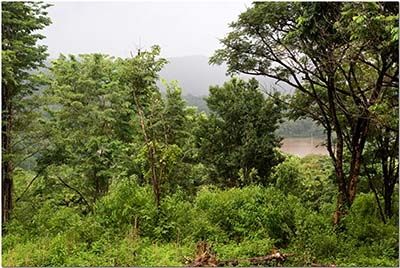
By now you’ll have descended in to a lush green valley filled with thick forests, rivers, reservoirs, and small picturesque towns. Everything looks mostly the same, quant small village after quaint small village for about the next 40-50 km.
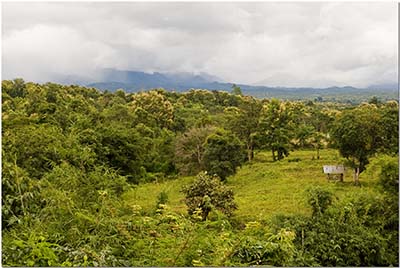
For the rest of the trip you’ll have some minor ascents and descents, more forests, more small towns, and a very relaxing time. As always, there is no shortage of great places to eat, places to fill up the tank, and vista points to stop and admire the view.
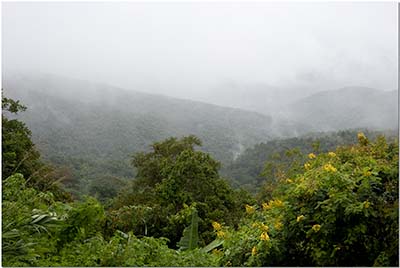
For the last two hours your senses have been overloaded with the sights and smells and lower temperatures of this beautiful mountainous region IN THAILAND. Beautiful and exotic Chiang Rai is almost anticlimactic in comparison. The drive is mentally taxing due to the roads, environment, and poorly suited vehicle, and I was driving a very popular late model SUV in perfect condition. That night my assistant and I were almost asleep when she said “I can still see it in my mind..” So could I.. A drive I highly recommend to anyone missing the mountains and forests of their own country.
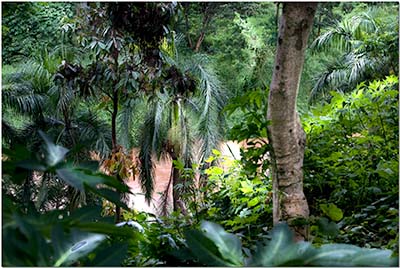
Using DOF for Portraits
Portraiture is perhaps one of the more obvious ways we use depth of field (DOF) as a compositional element. By varying the amount of the scene which is in focus, we lead the viewer to see/focus on exactly what we wish them to. We can greatly vary the ‘impact’ of a portrait through the creative use of DOF and it’s really not that difficult to do. Lets take a look at some portraits and discuss the use of DOF in each.
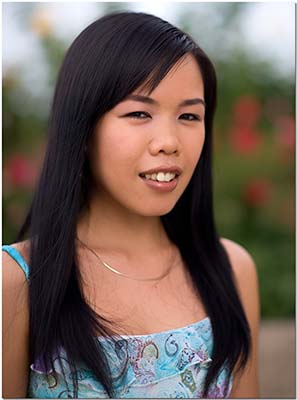
This is a pretty standard portrait of a young Thai girl. It’s a head and shoulders shot, common pose, and it includes only the parts of her necessary in such as shot so so her face is prominent in the frame without being overwhelming. Beyond the young girl is the background and as all too common this background is not very nice (weeds mostly) and if it were in focus it would probably distract the viewer from the main subject (pretty Thai girl). So, we plan the portrait to throw the background out of focus as much as possible. Remember how we control DOF to get a shallow DOF? The wider (more open) the aperture, the closer (more near your subject) the focal distance, the greater (more magnification) your focal length, the LESS your DOF.
In this portrait our aperture was F1.4, we were six feet from the subject, and the focal length was 85mm. We couldn’t have moved closer with a 85mm lens because her head/shoulders took up the entire frame at this distance. We could have
increased the focal length to 135mm or 300mm, which would have required increasing the focal distance for proper framing, so in this case increasing focal length would have been a wash. I wanted the background as out of focus as possible for this
pose.
The only other thing I could have done was open the lens one stop wider to it’s maximum of F1.2. Why didn’t I do that? Take a look at her eyes. In this view you can see that at first glance both appear in focus. Look closer.
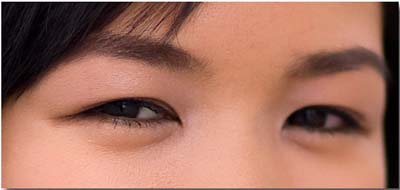
Notice that her CLOSEST eye is in very sharp focus, but her other eye is slightly blurred? At these settings our DOF is only 3 inches, less distance than from eye to eye. The focus point is her closest eye, and from there we lose focus outwards. The portrait works, but I caution you. Shooting at F1.2-F2 requires special techniques and a lot of experience and patience. Many people buy the lens, try this, and end up thinking the lens is defective. It’s not, it just takes knowledge, experience, skill, and patience.
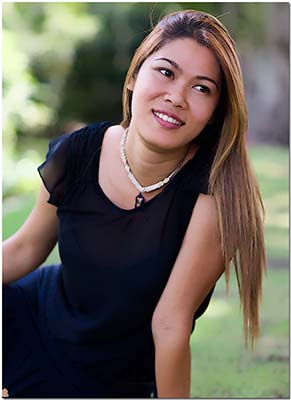
Look at this next portrait. Pretty much the same, but with two major differences. The pose allows more of the subjects body in the frame which means a longer focal distance, and the background being grass and flowers is far more attractive so we don’t need it to be as out of focus as the last one. Remember how we control DOF? The wider (more open) the aperture, the closer (more near your subject) the focal distance, the greater (more magnification) your focal length, the LESS your DOF.
Sorry, I can’t repeat this line enough. We need to memorize it and be able to quickly process the variables as we shoot portrait.. Same camera settings, 85mm focal length, aperture F1.4, but the focal distance has increased to roughly 12
feet. This gives us a DOF of six inches, plenty to keep both eyes in focus, and hair on both sides of the face.
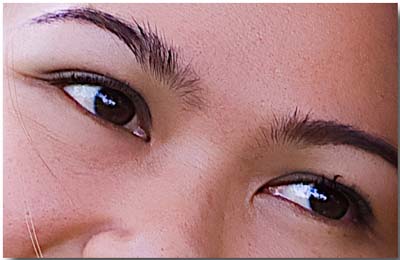
Can you see how both eyes are sharp and in focus? The eyebrows are well defines, skin pores evident, wisps of hair sharp? As an added note, notice that she isn’t looking at the camera? A subject doesn’t always need to engage the camera, often the portrait will be enhanced if they don’t.
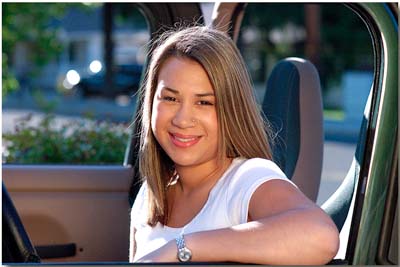
This portrait extends the DOF even further out, but this one gets a bit tricky. She wanted to clearly show she was in her Jeep, but the background was less than attractive and definitely a distracter. I was able to compute DOF in my head as I was composing the shot and roughly determine the settings necessary to keep the subject and the Jeep in focus, and the background out of focus. The settings were 85mm, F4, and a focal distance of roughly ten feet.
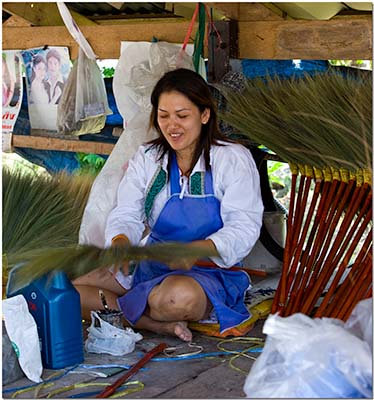
This next portrait needed to say and show more than a face. This lady worked making brooms and brushes and I wanted the portrait to be more environmental, to show her workspace, materials, and tools of her trade. Everything needed to be in focus in the entire frame. The settings were 73mm, F8, and a focal distance of roughly 15 feet.
Definition: I’m sure you’re wondering what that out of focus area is called? The out of focus portion of the image is called BOKEH.
This is a Japanese word and originally meant beautiful, smooth, and out of focus, the components of “desirable” bokeh. Notice how smooth and creamy the bokeh is in the first two portraits? Bokeh is created/effected by the aperture, lens, number of aperture blades, and settings. The best lenses will normally have the best bokeh and nine aperture diaphragm blades. In this case I was using Canon’s excellent 85mm F1.2 USM L lens, roughly a $1500 lens. In the last environmental portrait, as in most studio portraits, bokeh wasn’t desired so I choose a quality zoom lens for it’s sharpness, color and contrast, and the zoom which makes my job as the photographer much easier. This was a Canon 24-70mm F2.8 USM L lens, roughly $1200. It has seven diaphragm
blades. It’s bokeh is “ok”, but noticeably more rough and not nearly as creamy and soft. There are many $200-$300 zooms capable of creating bokeh, but the bokeh becomes so rough and unattractive that you hate to use the camera that way. Bokeh is a major consideration of a professional
photographer specializing in portraiture and weddings. We’ll often change the lens out with one of the same focal length, just because we’ll get better bokeh with the other.
Photography News of Interest
Bangkok is host to several photographic equipment shows each year. The next one is Photo World and will be held from October 16-19th. Don’t miss it! You can learn more about it here.
An excellent article on using contrast to help compose and form your portrait photos. Here.
Almost everyone is familiar with National Geographic as they’ve reliably published some of the finest photography anywhere. This article shows their Top 10 Science Photography images which are pretty awesome.. check them out.
BIG SIGH.. How this stuff happens and keeps happening for years before the victim speaks up is always hard to understand. A photography teacher sexually assaulting his 14 year old high school student in the darkroom! I hope his five years in jail are complete with a new set of “darkroom” experiences.. Read about it here.
Readers' Submissions
No readers submissions this week. If you have anything you’d like to share please send it in for next week.
I suspect the readers' submissions will be a highly anticipated section of this column and I encourage anyone with photographs and travel accounts they’d like to share to please send them to me at: QandA@Bkkimages.com
Readers' Questions
First Steve that's a great shot of Ankor Wat. What camera, lens and settings did you use for the shot? Steve I'm soon going to buy a Canon camera, the new 5D when it comes out, and was wondering what 4-5 lenses you would think would be best? Retiring soon to Thailand and this will be my hobby while here.
Regard: Doug
Hello Doug –
Nice to hear from you. I’ll answer your question via email and if you don’t mind I’ll run this answer in next weeks column so other people can benefit as well?
Thanks for your comments about the Angkor Vat shot. The full size image is stuffing. I’ll attach a crop so you can get a feel for the lens I used.
The camera was a Canon 1ds Mark II. The lens was a Canon 24-105mm USM IS L lens. Many people compare the Canon 24-70mm F2.8 USM L lens to the 24-105 and ask which one they should get. The optical differences are very small with the edge going to the 24-70. The 24-105 however provides extra reach and image stabilization. You much make the decision on which lens based on the above differences and your unique personal needs.
I mounted the DSLR on a good tripod and set the aperture F11, ISO 100, 47mm, and the shutter at 1/20th using mirror lockup and an external shutter release.
The new Canon 5d Mark II promises to be a significant upgrade to the 5d it replaces, and it’s image quality promises to be the best yet from Canon. Personally I’ll wait until its been tested by a few places and the verdict it out, but either way its probably a safe bet.
You ask about what “4-5” lenses would be “best.” Really, this depends on you and your photography needs and experience. It might be better to ask what lenses pack the most value for a given budget to accomplish your needs, and then list your needs as specifically as you can. Some lenses match the 5d Mark II’s body size and weight better than others while performing very close to their closest choices. Without more information, if I must list some lenses, I think you couldn’t go wrong with the “F4 zoom series” which includes the Canon 17-40mm F4, Canon 24-105mm F4 IS, Canon 70-200mm F4 IS, and perhaps the Canon 300mm F4. To go much beyond this recommendation you’d need to be very specific as to your needs.
Most people when the first start out with a DSLR don’t really know their needs. In this instance it would be a mistake to buy 4-5 lenses. Perhaps it would be better to start with a high quality zoom in the most commonly used focal length which includes image stabilization and great image quality. This lens would be the Canon 24-105mm F4 USM IS L lens. It would probably be better to wait and add more lenses as you develop your needs and experience. You can buy Canon lenses here in Thailand at very good prices, very close to the states (up or down), with a full warranty here in Thailand.
I hope this helps
Steve
REPLY
Thank you Steve, I wasn't planning on buying the camera until around April next year anyhow. That way there should be a lot of reviews out by then. I thought the camera and lenses would be more here than the states, I will have a look around and price out a few things in Bangkok before I fly back home on October 3rd, if not I'll check at Christmas that way they should have a price on the Canon 5D Mark 11 as well. The lenses I was thinking about were the EF 85mm f/1.2L II USM, EF 16-35mm f/2.8 II USM, EF 135mm f/2.0L USM, 70-200mm f/2.8L USM, and 24-105mm f/4L USM. There should be some rebates or discounts on the lenses sometime between now and next June, they seem to offer them every year from what I have seen. These lenses are a little on the high side for starting out. The lenses you listed would be good too and I may take your advice and just buy the one lens for now, and see what I really need. The company's giving me the money for hanging around until April 1st and a good camera and lenses were going to be my retirement present to myself. Thank you Steve for your help.
Best Regards: Doug
MY FOLLOW UP REPLY:
Doug –
Keep in mind that many people buy, sell, buy the same things again, sell again, and go through many cycles with photography equipment. Why? Many don’t take the time to discover their own style and what they really need, but most think equipment will make them a better photographer and when one lens doesn’t do it they think another will. Many think if you just buy the best lenses available that will do it.
The hard truth is, is that the better the lens is, the more specialized skill it takes to use it effectively. But when you do learn WOW, the images are stunning. The two lenses you mentioned, the Canon 85mm F1.2 USM and Canon 135 F2 USM are two such lenses. Both are highly specialized (especially the 85/1.2) and take a fair amount of skill to really learn to use well. Be sure to take a look at next weeks learning topic (DOF and Portraits) as there will be some good information there with some decent examples. I could easily spend a few days teaching someone to use just one of these lenses, and I’ll often spend an entire day with a student helping them discover just what jewels these lenses really are. Many people buy them, discover bokeh, and think they’ve learned how to use them because they can achieve bokeh in their images.. but there’s so much more.
I have the Canon 70-200mm F2.8 IS USM L lens. Great lens. It’s ideally matched for a 1d series body and will feel a bit lopsided with a 5d body. If I was buying today I would very seriously consider the 70-200mm F4 IS USM L lens because image quality wise it’s 99.9% of the F2.8 version, plus it’s a lot lighter and smaller which becomes very important on a 5d body and when traveling around Thailand.
I also have the Canon 16-35mm F2.8 USM L lens. It’s a nice lens, but I find myself using the Sigma 12-24 F4 lens 10x more often and with better results. I also have 4-5 other wide angle lenses I choose from. My rule of thumb, is that if I can shoot at F8 or smaller I’ll take the Sigma. If I shoot wider than F8 I’ll take the Canon. These are my main two wide angle zooms and I love both. The Sigma btw is only about $500! The Canon 17-40 has every bit the image quality as the 16-35 at half the price. You give up the F2.8.. but with a wide angle you’d rarely.. and I mean very rarely.. shoot at F2.8, F4, or even F5.6 anyway.
There is a shop in Mall Bangkapi who routinely beats the prices of what Canon equipment (and I assume other equipment as well) costs in the states via mail order discounters. I’ll be doing a lot of business with them in the future.
I can’t think of a better retirement present! But I really do think the one lens mentioned (the 24-105) will keep you busy with the 5d Mark II for quite some time before you need other lenses.. and Canon will be offering the 5d Mark II and the 24-105 in a package with a savings of several hundred dollars. If you will be moving to Thailand immediately after the purchase, do consider buying your gear locally so you’ll have warranty coverage. Canon has an excellent service center here in Bangkok which I use all the time.
I hope all this helps.
Steve
Please submit your questions to QandA@Bkkimages.com All questions will be answered and most will show up in the weekly column.
A Snapshot of Bangkok Images Week in Review
Another busy and hectic week. I’ve still got over 3000 new images waiting to be cataloged, a book cover assignment I need to get proactive on, and some new galleries for my website that need to be put up. No workshop students this week, but several photo services projects have been commissioned.
A few weeks ago FedEx knocked on the door and delivered a copy of a small booklet I’d been commissioned to provide the photography for. I was pleased to see that every image in the book was provided by Bangkok Images and that many were used. It’s always nice when a client follows up on a commission with copies of the final output so you can see your work as intended. A few websites where the images were used were also referenced and I’ll link there here if anyone is curious enough to check them out. There is also a 1mb PDF version of the booklet I can email to anyone who is interested.
Mirrored Blog
I haven’t had time to sort out my blog issue yet, but I hope to get to it week after next and to be able to bring you more of my archived blogs.



